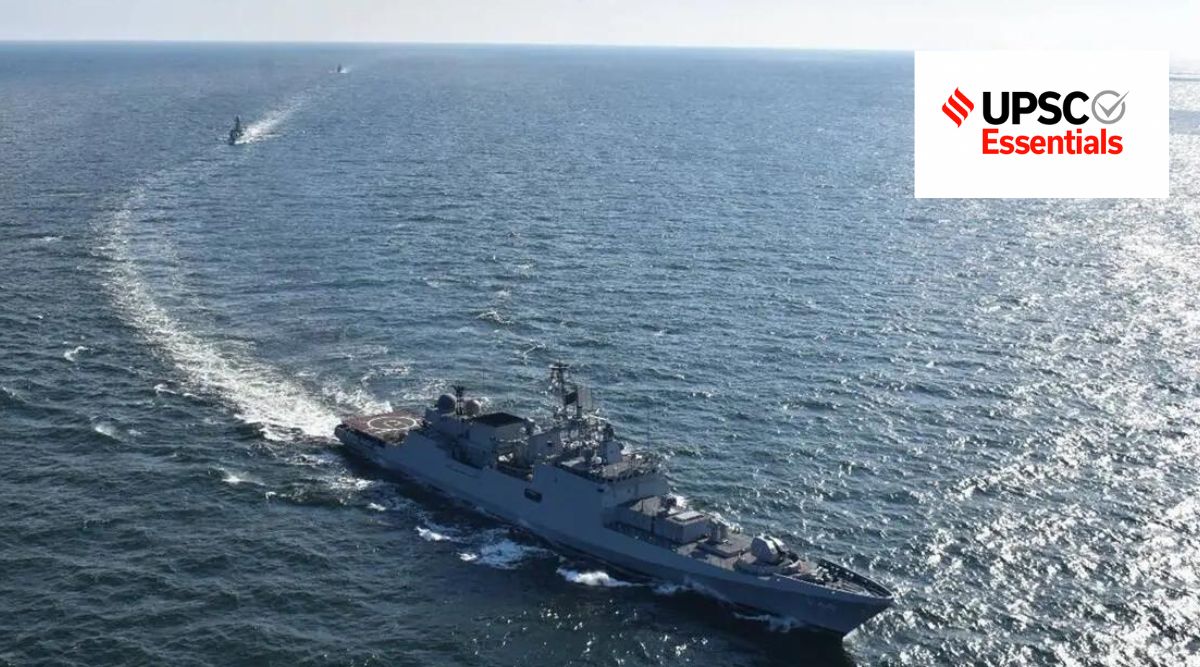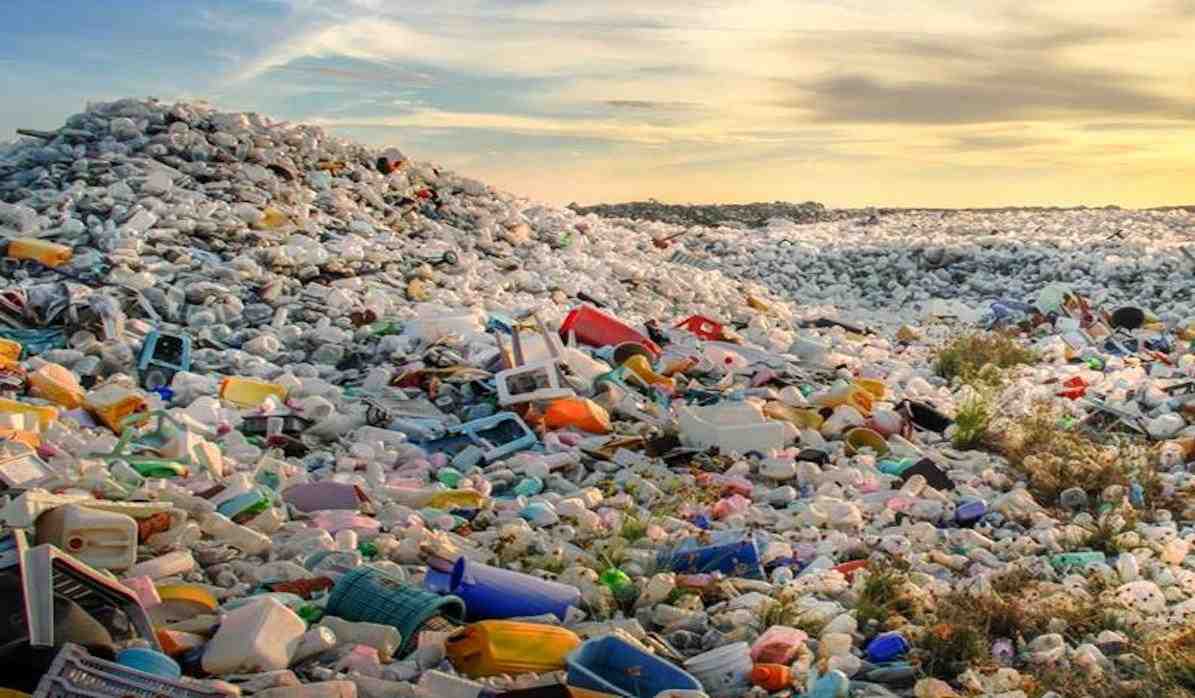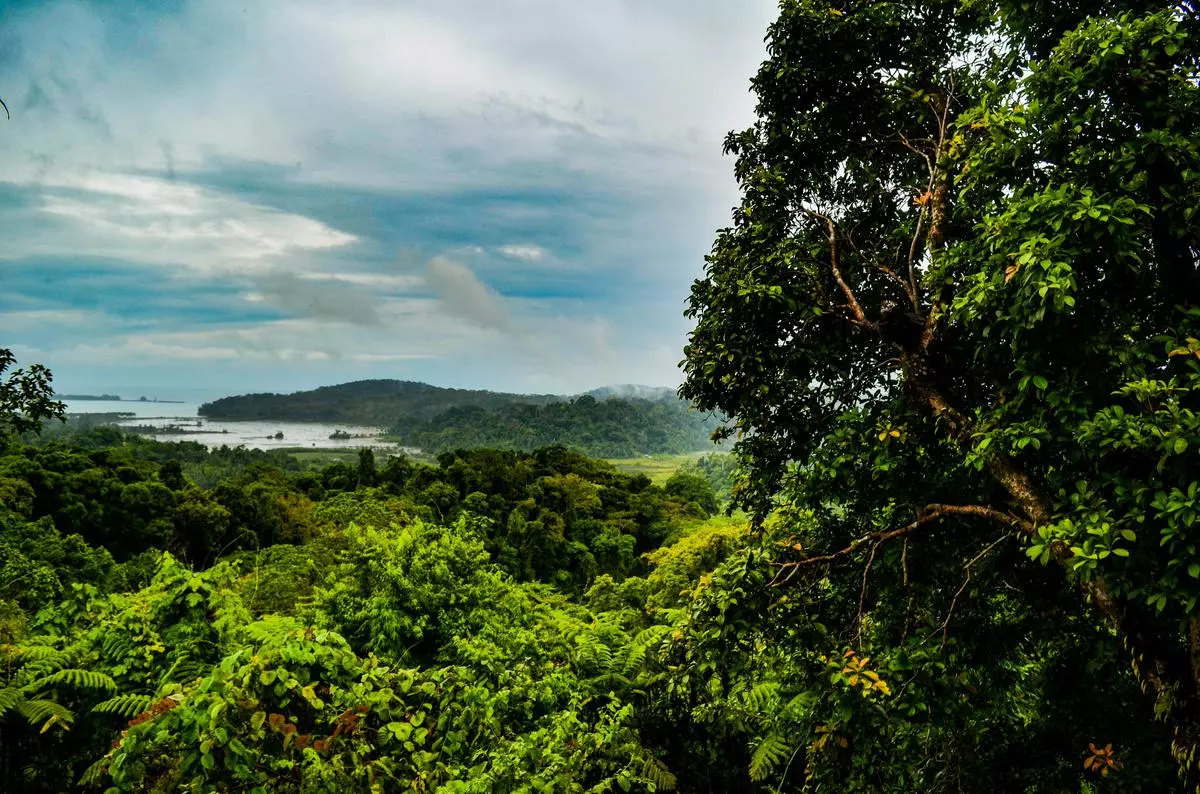The Indian Express’ UPSC weekly information categorical covers a number of the most vital subjects of present affairs information from this week that will help you put together for UPSC-CSE. Try out the MCQs, Points to ponder and examine your solutions supplied in direction of the top of the article.
‘Code of Conduct’ within the South China Sea
Syllabus:
Preliminary Examination: Current occasions of nationwide and worldwide significance.
Main Examination: General Studies II: International Affairs
Why in information?
— On Wednesday (November 23), Defence Minister Rajnath Singh addressed the ASEAN (Association of Southeast Asian Nations) Defence Ministers’ assembly in Cambodia. He expressed hope that the continuing negotiations on the Code of Conduct for the South China Sea will probably be per worldwide legislation, significantly the United Nations Convention on the Law of the Sea (UNCLOS).
KEY TAKEAWAYS
— The South China Sea is without doubt one of the most contentious areas on the planet with a number of international locations having territorial claims over its waters and islands. Amidst China’s rising army aggression, the destiny of the area has turn out to be of worldwide concern.
What has the battle within the South China Sea been about?
— The South China Sea lies simply south of the Chinese mainland and is bordered by the international locations of Brunei, China, Indonesia, Malaysia, Philippines, Taiwan and Vietnam. As early because the Seventies, these international locations started to say islands (largely uninhabited) all through the ocean to put management over the assorted assets that the area possessed, similar to untapped oil reserves, pure gasoline, and fishing areas. It additionally has a number of the most energetic transport lanes on the planet.
— Today, China’s sweeping claims over the ocean have antagonised different international locations within the area. China claims the ocean as its Exclusive Economic Zone (EEZ), arguing that different international locations don’t have the proper to conduct any army or financial operation with out its consent.
— This declare is disputed by the southeast Asian international locations and in 2016, the Permanent Court of Arbitration at The Hague issued its ruling on a declare introduced in opposition to China by the Philippines beneath UNCLOS. It dominated in favour of the Philippines on virtually each rely. However, China, which itself is a signatory to UNCLOS, refused to acknowledge the court docket’s authority.
— Recent satellite tv for pc imagery of the area has had destabilising results, displaying China’s efforts to not solely improve the scale of current islands however create synthetic islands throughout the area. According to the Council on Foreign Relations, China has constructed ports, army installations, and airstrips in these islands — significantly within the Paracel and Spratly Islands, the place it has twenty and 7 outposts, respectively. China has additionally militarised Woody Island by deploying fighter jets, cruise missiles, and a radar system.
— To shield the stability of energy within the area, international locations just like the United States and Japan have come to assistance from the south-east Asian international locations, offering them with army and financial help.
What is the Code of Conduct for the South China Sea?
— In 1995, China illegally occupied the Mischief Reef, simply 210 km from the Philippine island of Palawan. Other ASEAN international locations noticed it as a blatant try to change the established order within the area.
— As a response, ASEAN issued a Joint Communiqué in 1996 expressing concern over the state of affairs within the South China Sea and calling “for the peaceful resolution of the dispute and self-restraint by parties concerned.” Further, a regional code of conduct was proposed, which might “lay the foundation for long term stability in the area and foster understanding among claimant countries.”
— After years of painful negotiation between ASEAN and China, a non-binding, aspirational Declaration of Conduct (DOC) within the South China Sea was arrived at in 2002. This was speculated to be an vital stepping stone for the creation of a binding Code of Conduct that will guarantee peace and stability within the area. However, China continued occupying extra islands and resorting to army actions, inflicting ASEAN international locations to precise issues about their sovereignty and pursuits.
— For the previous 20 years, this has largely been the truth of the area. On one hand, China has stonewalled any makes an attempt to reach at a binding Code of Conduct. On the opposite, it has continued its personal expansionist insurance policies, making the area extraordinarily risky.
— According to Ian Storey, a senior fellow on the ISEAS-Yusof Ishak Institute in Singapore, there have been three main sticking factors which have stalled any progress in direction of a Code of Conduct.
Storey wrote in Foreign Policy, “First, what should the geographical scope of the agreement be? Should it include the Paracel Islands, as Vietnam wants but China doesn’t, or Scarborough Shoal, as the Philippines wants but China doesn’t. Second, should the COC [code of conduct] include a list of dos and don’ts? Beijing won’t want to tie its hands by agreeing to a ban on those activities. Third, should the COC be legally binding? Most ASEAN member states appear to support that, but China is opposed.”
(Source: With Rajnath Singh’s feedback at ASEAN assembly, a have a look at the makes an attempt for a ‘Code of Conduct’ within the South China Sea by Arjun Sengupta. Follow Arjun Sengupta’s Explained articles.)
Point to ponder: How the South China Sea state of affairs performs out will probably be vital for India’s safety ?
1. MCQ:
Which of the next international locations border South China Sea?
1. Brunei
2. Cambodia
3. China
4. Indonesia
5. Laos
6. Vietnam
a) 1, 3, 4, 6
b) 2,3, 4, 5
c) 1, 3, 4, 5, 6
d) 1, 2, 3, 4, 5, 6
National Suicide Prevention Strategy
Syllabus:
Preliminary Examination: Current occasions of nationwide and worldwide significance.
Main Examination: General Studies II: Issues referring to improvement and administration of Social Sector/Services referring to Health, Education, Human Resources.
Why in information?
— The Ministry of Health and Family Welfare on Monday (November 21) unveiled the National Suicide Prevention Strategy — the first-of-its-kind coverage formulated by the federal government to stop suicides as a public well being precedence.
KEY TAKEAWAYS
— According to the ministry, the coverage that can set the stage for promotion of psychological well being and prevention of suicides within the coming decade.
— The objective of the technique is to scale back suicide mortality within the nation by 10 per cent by 2023. The technique supplies a framework for a number of stakeholders to implement actions for prevention of suicides within the nation.
National Suicide Prevention Strategy: Objectives
— There are three most important aims of the technique.
First, it seeks to determine efficient surveillance mechanisms for suicide throughout the subsequent three years.
Second, it seeks to determine psychiatric outpatient departments that can present suicide prevention providers by the District Mental Health Programme in all districts throughout the subsequent 5 years.
Third, it goals to combine a psychological well-being curriculum in all academic establishments throughout the subsequent eight years.
The fourth goal of the National Suicide Prevention Strategy is to strengthen surveillance of suicide and additional technology of proof by analysis, that can guarantee enchancment within the programme high quality.
Stakeholders in implementation framework
— The implementation framework of the National Suicide Prevention Strategy envisions 5 key stakeholders answerable for realising the aims. These embody national-level ministerial stakeholders, state-level governmental stakeholders, district-level governmental stakeholders, NIMHANS-Bangalore and different high psychological well being institutes, and strategic collaborators.
Implementation mechanism
– Reinforcing management, partnerships and institutional capability within the nation
– Enhancing the capability of well being providers to supply suicide prevention providers
– Developing group resilience and societal help for suicide prevention and cut back stigma related to suicidal behaviours.
Suicides in India: What’s the present situation?
— According to the annual report of the National Crime Records Bureau (NCRB), launched in August, 1.64 lakh folks died by suicide in 2021 — a rise of seven.2 per cent from 2020. This is 10 per cent increased than the COVID deaths (1.48 lakh) in India in 2020, and 6.8 instances the maternal deaths (23,800) in the identical yr.
— The NCRB report additionally said that greater than 1,00,000 folks die by suicide within the nation yearly. A complete of 25,891 suicides had been reported within the 53 megacities of the nation throughout 2021, with the best in Delhi.
— In the previous three years, the suicide charge within the nation has elevated from 10.2 to 11.3 per 1,00,000 inhabitants. Most suicides in India are by youth and middle-aged adults — with 65 per cent of the suicides in 2020 being reported within the age group of 18-45 years.
Ongoing suicide prevention initiatives in India
— The National Mental Health Policy (2014) sees prevention of psychological problems, discount of suicide and tried suicide as core precedence areas.
— The Mental Healthcare Act 2017 introduced in some vital modifications. The Act that got here into drive from May 2018 successfully decriminalised tried suicide, which was punishable beneath Section 309 of the Indian Penal Code. It ensured that the people who’ve tried suicide are supplied alternatives for rehabilitation from the federal government versus being tried or punished.
— Several nationwide programmes such because the National Mental Health Program, National Palliative Care Program, Ayushman Bharat and Nasha Mukti Abhiyaan Task Force are additionally in place.
(Source: National Suicide Prevention Strategy: Framework and aims by Sheji S Edathara )
Point to ponder: Suicide is the epidemic we’re overlooking. Do you agree?
2. MCQ
With respect to National Crime Records Bureau (NCRB), take into account the next statements
1. NCRB, headquartered in New Delhi, was set-up in 1986 beneath the Ministry of Health.
2. ‘Accidental Deaths and Suicides’ is certainly one of its main publication.
Which of the statements is/are right?
a) Only 1 b) Only 2
c) Both 1 and a pair of d) Neither 1 nor 2
China and India inhabitants
Syllabus:
Preliminary Examination: Economic and Social Development
Mains Examination: General Studies I: Population and related points
Why in information?
—This yr and the subsequent will see two landmark demographic occasions. In 2022, China will for the primary time register an absolute decline in its inhabitants. And in 2023, India’s inhabitants, projected by the United Nations to achieve 1,428.63 million, will surpass China’s 1,425.67 million.
KEY TAKEAWAYS
Mortality and fertility
— Mortality falls with elevated training ranges, public well being and vaccination programmes, entry to meals and medical care, and provision of secure consuming water and sanitation amenities. The crude dying charge (CDR) — the variety of individuals dying per yr per 1,000 inhabitants — was 23.2 for China and 22.2 for India in 1950. It fell to single digits for China first in 1974 (to 9.5) and for India in 1994 (9.8), and additional to 7.3-7.4 for each in 2020.
— Another mortality indicator is life expectancy at start. Between 1950 and 2020, it went up from 43.7 to 78.1 years for China and from 41.7 to 70.1 years for India.
— Reduction in mortality usually results in a rising inhabitants. A drop in fertility, however, slows down inhabitants progress, finally leading to absolute declines. The whole fertility charge (TFR) — the variety of infants a mean girl bears over her lifetime — was as excessive as 5.8 for China and 5.7 for India in 1950.
— The TFR has fallen sharply for India within the final three a long time. Between 1992-93 and 2019-21, it got here down from 3.4 to 2; the autumn was particularly important within the rural areas. In 1992-93, the typical rural Indian girl produced one additional youngster in comparison with her city counterpart (3.7 versus 2.7). By 2019-21, that hole had halved (2.1 versus 1.6).
— A TFR of two.1 is taken into account as “replacement-level fertility”. Simply understood, a girl having two kids principally replaces herself and her associate with two new lives. Since all infants could not survive to understand their reproductive potential, the substitute TFR is taken at barely above two. It ensures that every technology replaces itself.
If India’s TFR is already below-replacement, why is its inhabitants nonetheless growing?
Sustained lows vital
— The TFR is the typical variety of births by girls aged 15-49 based mostly on surveys for a specific interval/yr. Populations can continue to grow even with TFRs falling. De-growth requires TFRs to stay beneath substitute ranges for prolonged intervals. The results of that — fewer kids at present changing into dad and mom tomorrow and procreating simply as a lot or much less — could replicate solely after a few generations.
— China’s TFR dipped beneath substitute first in 1991, which was virtually 30 years earlier than India’s. Recall that the CDR decline beneath 10, too, occurred twenty years earlier for China. Not stunning, China’s inhabitants greater than doubled from 544 million in 1950 to 1.1 billion in 1987 — underpinned by falling CDRs — and continued to develop, peaking at 1,426 million in 2021. It took over 30 years for below-replacement fertility charges to translate into adverse inhabitants progress.
China faces a disaster
— China’s TFR, in accordance with its 2020 Census, was 1.3 births per girl — marginally up from the 1.2 within the 2010 and 2000 censuses, however method beneath the substitute charge of two.1. China formally ended its one-child coverage, launched in 1980, from 2016. The UN, nonetheless, initiatives its whole inhabitants at 1.31 billion in 2050, a 113 million-plus drop from the 2021 peak.
— The actual disaster for China, nevertheless, is the decline in its inhabitants that’s of prime working age. The proportion of the inhabitants aged between 20 and 59 years crossed 50% in 1987 and peaked at 61.5% in 2011. This interval additionally coincided with excessive financial progress, with China efficiently harnessing the “demographic dividend” that comes from a younger labour drive.
— If there’s a giant inhabitants that’s in a position to work and earn, not solely will there be comparatively fewer folks to help these too previous or too younger — but in addition better tax revenues and financial savings potential from the technology of incomes. As these are directed to finance investments, a virtuous cycle of progress is unleashed — as certainly it occurred in China.
— But that cycle has began to reverse, and the share of China’s working-age inhabitants is projected to fall beneath 50% by 2045. In quick, China faces the prospect of a dwindling labour drive having to help a quickly growing old inhabitants.
India has a chance
— India has simply begun seeing fertility charges fall to substitute ranges, together with in rural areas. The latter has to do with the unfold of training — and, maybe, additionally farm mechanisation and fragmentation of landholdings. Reduced labour requirement in agricultural operations and smaller holdings make it that a lot much less essential to have giant households working the land.
— But even with fertility charge declines, India’s inhabitants is projected to develop and de-grow solely after touching 1.7 billion about 40 years from now. More vital is the working-age inhabitants: its share within the total inhabitants crossed 50% solely in 2007, and can peak at 57% in direction of the mid-2030s.
— In absolute phrases, the inhabitants aged 20-59 years will improve from 760 million in 2020 to almost 920 million in 2045. The median age of India’s inhabitants additionally is not going to go up a lot — from 27.3 years in 2020 to 38.1 in 2050 — including as much as a much less miserable prospect than China’s.
— Overall then, India has a window of alternative effectively into the 2040s for reaping its “demographic dividend”, like China did from the late Nineteen Eighties till as much as 2015. That is, after all, contingent upon the creation of significant employment alternatives for a younger inhabitants.
Share of workforce in agriculture has slowed
— Agriculture accounted for round 65% of the nation’s employed labour drive in 1993-94. That share fell considerably to 49% by 2011-12. But the pattern has slowed, if not reversed, thereafter.
— Going ahead, the problem earlier than India’s policymakers is to advertise progress that generates jobs exterior of agriculture. These mustn’t merely be in building and low-paid casual providers.
— The surplus labour from farms ought to discover employment in sectors — manufacturing and fashionable providers — the place productiveness, value-addition and common incomes are increased. In the absence of such structural transformation, the “demographic dividend” might effectively flip right into a “demographic nightmare”.
( Source: China and India inhabitants: Implications of slowing dragon, racing elephant by Harish Damodaran)
Point to ponder: With India set to turn out to be most populous nation how can it’s affluent too?
3. MCQ:
To receive full advantages of demographic dividend, what ought to India do?
a) Promoting ability improvement
b) Introducing extra social safety schemes
c) Reducing toddler mortality charge
d) Privatization of upper training
Development of Great Nicobar
Why in information?
— Last month, the Ministry of Environment, Forest and Climate Change gave environmental clearance for the formidable Rs 72,000 crore improvement undertaking on the strategically vital Great Nicobar Island. The undertaking is to be applied in three phases over the subsequent 30 years.
KEY TAKEAWAYS
The proposal
— A “greenfield city” has been proposed, together with an International Container Transhipment Terminal (ICTT), a greenfield worldwide airport, an influence plant, and a township for the personnel who will implement the undertaking.
— The port will probably be managed by the Indian Navy, whereas the airport can have twin military-civilian features and can cater to tourism as effectively. Roads, public transport, water provide and waste administration amenities, and several other accommodations have been deliberate to cater to vacationers.
— A complete 166.1 sq km alongside the southeastern and southern coasts of the island have been recognized for undertaking alongside a coastal strip of width between 2 km and 4 km. Some 130 sq km of forests have been sanctioned for diversion, and 9.64 lakh bushes are more likely to be felled.
— Development actions are proposed to start within the present monetary yr, and the port is anticipated to be commissioned by 2027–28. More than 1 lakh new direct jobs and 1.5 lakh oblique jobs are more likely to be created on the island over the interval of improvement.
The Island
— Great Nicobar, the southernmost of the Andaman and Nicobar Islands, has an space of 910 sq km. The Andaman and Nicobar Islands are a cluster of about 836 islands within the japanese Bay of Bengal, the 2 teams of that are separated by the 150-km huge Ten Degree Channel. The Andaman Islands misinform the north of the channel, and the Nicobar Islands to the south.
— Indira Point on the southern tip of Great Nicobar Island is India’s southernmost level, lower than 150 km from the northernmost island of the Indonesian archipelago. Great Nicobar is dwelling to 2 nationwide parks, a biosphere reserve, and the Shompen and Nicobarese tribal peoples, together with ex-servicemen from Punjab, Maharashtra, and Andhra Pradesh who had been settled on the island within the Seventies.
— The Shompen are hunter-gatherers who rely on forest and marine assets for sustenance. The Nicobarese, who lived alongside the west coast of the island had been largely relocated after the 2004 tsunami. An estimated 237 Shompen and 1,094 Nicobarese people now dwell in a 751 sq km tribal reserve, some 84 sq km of which is proposed to be denotified. The roughly 8,000 settlers who dwell on the island are engaged in agriculture, horticulture, and fishing.
— The Great Nicobar Island has tropical moist evergreen forests, mountain ranges reaching virtually 650 m above sea degree, and coastal plains. Fourteen species of mammals, 71 species of birds, 26 species of reptiles, 10 species of amphibians, and 113 species of fish are discovered on the island, a few of that are endangered. The leatherback sea turtle is the island’s flagship species.
The objective
— The island has numerous tourism potential, however the authorities’s better objective is to leverage the locational benefit of the island for financial and strategic causes.
— Great Nicobar is equidistant from Colombo to the southwest and Port Klang and Singapore to the southeast, and positioned near the East-West worldwide transport hall, by which a really giant a part of the world’s transport commerce passes. The proposed ICTT can doubtlessly turn out to be a hub for cargo ships travelling on this route.
— The proposal to develop Great Nicobar was first floated within the Seventies, and its significance for nationwide safety and consolidation of the Indian Ocean Region has been repeatedly underlined. Increasing Chinese assertion within the Bay of Bengal and the Indo-Pacific has added nice urgency to this crucial lately.
The issues
— The undertaking web site is exterior the eco-sensitive zones of Campbell Bay and Galathea National Park. The Centre has mentioned that the event space is barely a small proportion of the realm of the island and its forest cowl, and that 15 per cent of the event space itself will probably be inexperienced cowl and open areas.
— The proposed huge infrastructure improvement in an ecologically vital and fragile area, together with the felling of just about 1,000,000 bushes, has alarmed many environmentalists. The lack of tree cowl is not going to solely have an effect on the wildlife on the island, it can additionally result in elevated runoff and sediment deposits within the ocean, impacting the coral reefs within the space, they’ve cautioned.
— Coral reefs, already beneath risk from warming oceans, are of huge ecological significance. Environmentalists have additionally flagged the lack of mangroves on the island on account of the event undertaking.
— India has efficiently translocated a coral reef from the Gulf of Mannar to the Gulf of Kutch earlier. The Zoological Survey of India is at present within the means of assessing how a lot of the reef must be relocated for the undertaking. The authorities has mentioned {that a} conservation plan for the leatherback turtle can also be being put in place.
— According to the federal government, expediting the undertaking is of paramount nationwide safety and strategic significance. Officials mentioned that after the grant of stage I clearance on October 27, all facets will probably be rigorously weighed earlier than remaining approval is granted.
(Source: Development of Great Nicobar: strategic crucial and ecological issues by Esha Roy)
4. MCQ:
Which one of many following pairs of islands is separated from one another by the ‘Ten Degree Channel’? (2014)
(a) Andaman and Nicobar
(b) Nicobar and Sumatra
(c) Maldives and Lakshadweep
(d) Sumatra and Java
ANSWERS TO MCQs: 1 (a), 2 (b), 3 (a), 4 (a)
The UPSC Essentials Indian Express is now on Telegram. Click right here to affix our channel and keep up to date with the most recent updates.
Note: Catch the UPSC Weekly Quiz each Saturday night and brush up in your present affairs data.

















